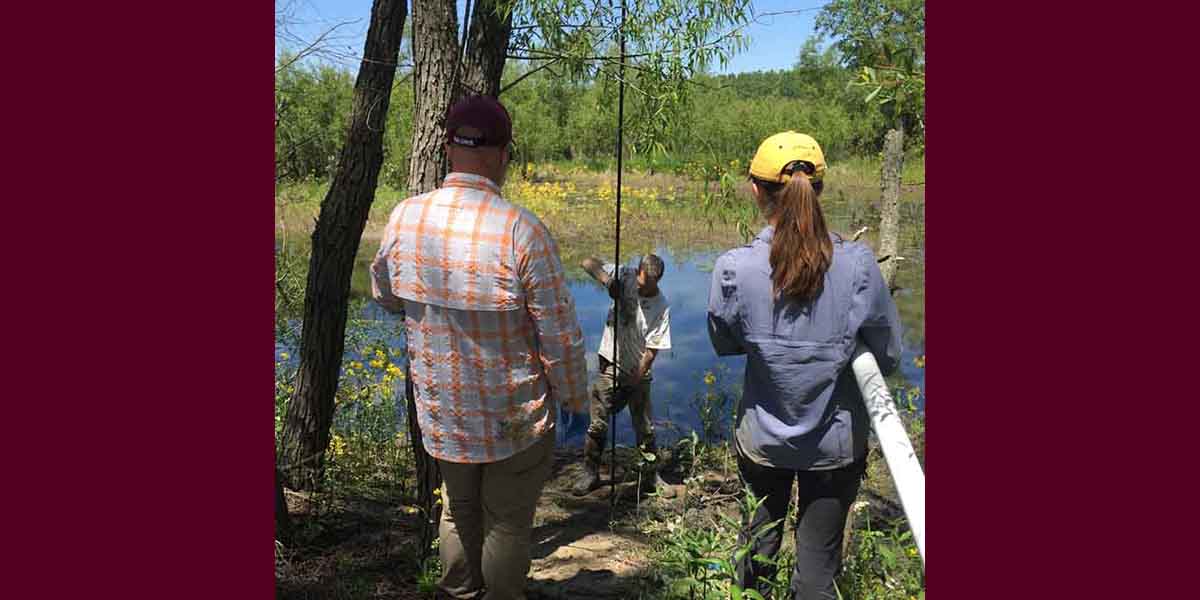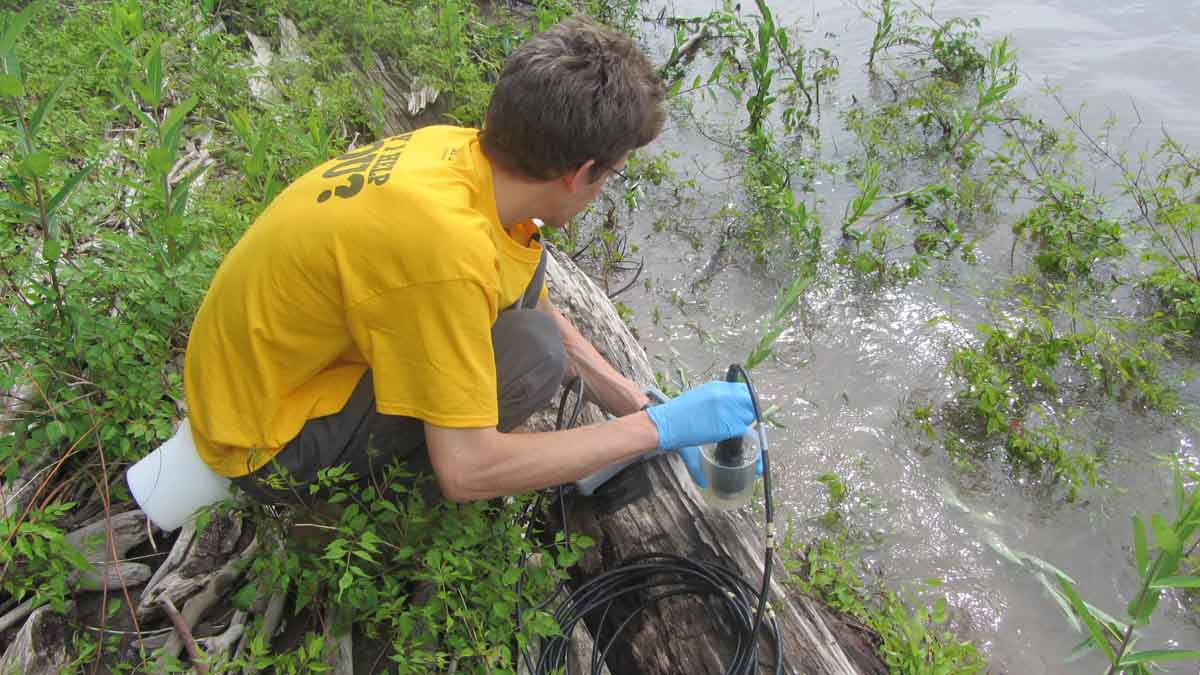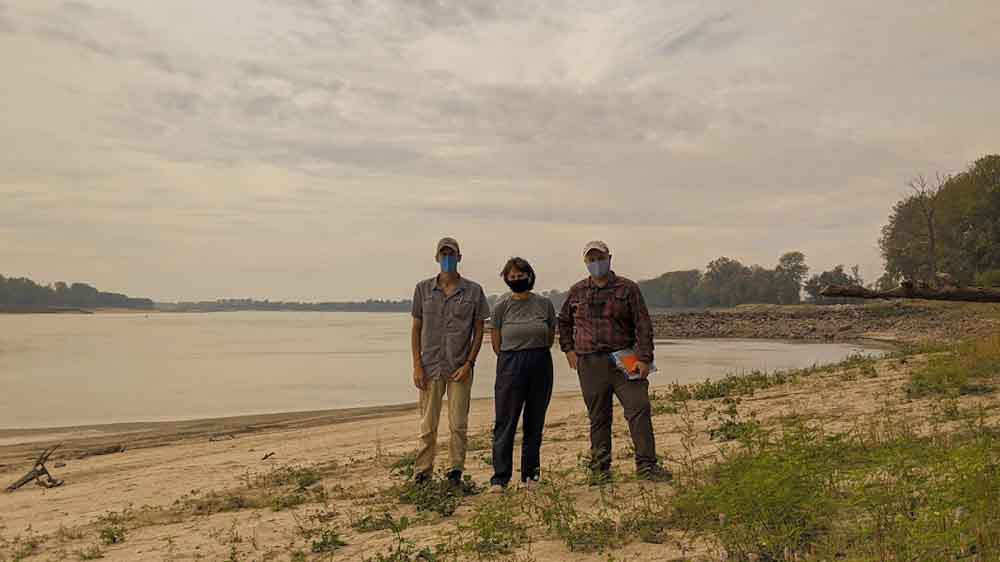
Jonathan Remo, associate professor in the School of Earth Systems and Sustainability, left, works with Cecilia Albert-Black, an undergraduate student in geology, right, and doctoral student Joseph Krienert to take samples along the Mississippi River. A team from Southern Illinois University Carbondale co-led by Remo and Liliana Lefticariu, associate professor of geology, is trying to identify and quantify the processes that reduce nitrogen pollution in several floodplain wetlands along the Middle Mississippi River. (Photo provided)
February 01, 2022
SIU researchers probe how Mississippi wetlands can help human life and the environment
CARBONDALE, Ill. – Researchers at Southern Illinois University Carbondale are trying to find out if a key to mitigating an ongoing environmental threat lies along the banks of the mighty Mississippi River.
A team co-led by Liliana Lefticariu, associate professor of geology in the School of Earth Systems and Sustainability, is trying to identify and quantify the processes that reduce nitrogen pollution in several floodplain wetlands along the Middle Mississippi River. The region stretches for 190 miles from the confluence with the Missouri River at St. Louis to its confluence with the Ohio River at Cairo.
Life-giving nitrogen, a key element in healthy plants and agriculture, can end up being too much of a good thing if its concentration in water is so high it becomes poisonous for people and wildlife. But studies in other regions around the world show wetland areas play a very important role in reducing nitrogen pollution by sustaining microbes that turn nitrogen pollutants into harmless nitrogen gas released into the atmosphere.
Used on countless acres by farmers and gardeners, the chemical washes away when applied in excess, finding its way into groundwater and streams, and emptying into major watersheds before ultimately landing in the Mississippi River and washing into the Gulf of Mexico. Livestock waste, septic effluent and Earth’s own atmosphere also provide such environmental inputs.
At high water concentrations, nitrogen can squeeze the oxygen out of the water while also giving rise to algae blooms that further choke the life out of the ocean near the river’s mouth.
The interdisciplinary SIU team also includes Jonathan Remo, associate professor of geography and team co-leader, doctoral student Joseph Krienert, and geology undergraduate student Cecilia Albert-Black. A partnership among The Nature Conservancy, American Rivers and the U.S. Department of Agriculture’s Natural Resources Conservation Service and other groups is funding the work.
But how does it work?
Wetlands have been shown to be up to five times more efficient at reducing nitrate pollution than the best available land-based nitrogen mitigation strategies, Lefticariu said. The team’s main goal is quantifying the nitrogen removal efficiency while identifying key factors that limit nitrogen removal in such riverine wetlands.
To do this, the team will examine hydrological characteristics using geochemical attributes such as the levels of various nitrogen types, including nitrates, nitrites, ammonia, and particulate nitrogen, as well as their measuring their stable isotope signatures. As the project expands, additional members also will investigate dynamics of the local microbial community to find out what role they play in processing and cycling nitrogen.
The stakes are high, with the work aimed at understanding and rolling back the so-called “hypoxic zone,” an oxygen-depleted “dead zone” of the Gulf of Mexico stretching from eastern Texas into Louisiana. The latest measurements estimate its size at 6,334 square miles, or equivalent to more than 4 million acres of habitat potentially unavailable to fish and bottom species.
“The Mississippi River epitomizes this crisis,” Lefticariu said. Along with the damage to wildlife, human-made nitrogen runoff results in more than $70 billion in economic damage annually. But it’s also a worldwide problem.
“Developing this knowledge base will provide critical information to river managers as they try to specify the type and area of wetlands needed to help mitigate environmental problems related to elevated nitrogen loads,” she said.
Complex systems
The team is using both laboratory and field studies, combined with computer modeling, to better understand how it all works. But there are multiple challenges.
Being the first study of such complexity in this area means there are many unknowns, and nitrogen cycling in any environment is a complicated affair. To deal with these factors, the team designed a step-by-step approach to studying various processes individually before assembling a self-contained test system within the larger wetland system.
They also are examining the differences in how hydrologically connected lands lying directly along the river deal with nitrogen, as opposed to those wetlands separated from the river by levees and thus not directly connected to the river. The river frequently floods the connected wetlands, mostly during spring when snow melts upstream, though flooding can occur at any time during a year depending on the weather conditions.
“In other places, there are levees that protect the land from flooding,” Lefticariu said. “But behind the levees, we can still find wetlands, which in these cases are not directly connected to the river, but we study them as well. And we have observed differences in terms of hydrological and bio-geochemical processes between these two types of wetlands, and we hope to learn more about efficiency of nitrate pollution reduction in these two types of wetlands.”
Important to the planet
As a worldwide issue, nitrogen runoff and the environmental problems it causes risk irreversible damage, along with abrupt environmental change, Lefticariu said. Average nutrient concentration trends in the Mississippi River have been increasing, and a coordinated effort is needed to stem the tide of dead zones.
“Our research is very important and timely since increasing nitrogen pollution can led to an environmental catastrophe,” she said, “and we need to develop strategies to prevent it.”


